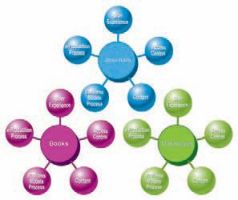Addressing changing demands on academic publishers
As more different types of research resources become available electronically, Atypon's Nash Pal argues that multiproduct platforms are the best way to ensure efficient access to all the information that researchers need

When academic publishers first began to make their content available electronically, most tackled the different types of content as separate products. This meant many publishers developed separate electronic platforms for e-books and e-journals. The rationale for this made sense: when electronic versions were first developed there were no immediately-obvious reasons for treating them differently from print.
Print books and journals traditionally belonged to different departments and had very different routes to market. At every stage of book and journal production and marketing, a different set of players and processes were involved. Even library conferences positioned themselves differently depending whether they focused more on journals, such as UKSG and NASIG, or books in the case of conferences like NAG and Charleston.
In most companies, the development of e-journals also preceded the development of e-books by as much as 10 years. This and the separation of the channels to market has led to the proliferation of application ‘silos’ that, at best, are loosely joined together to provide some minimal end-user benefits.
All this is changing, however. There is now a much wider variety of e-products and services available and end users and librarians now expect all content to be available online in an easy-to-find and integrated way. This is making it increasingly compelling to place all e-publications on the same platform, a multiproduct platform. This type of platform delivers a single integrated front and back end for all the publisher’s products and services, whether it be journals, books, databases or reference works.
Benefits to publishers and users
There are several benefits of multi-product platforms for both publishers and end-users. Firstly, publishers can save on costs and administration time. These can be significantly reduced because the management, maintenance and delivery of multiple content types can be achieved from a single integrated platform rather than the publisher producing, co-ordinating and maintaining different sites.
Users benefit by gaining access to content regardless of its type. A multi-product platform gives a uniform online experience for all electronic content, and allows users to search seamlessly across the breadth of relevant electronic information resources. It also helps users to refine searches in order to identify the exact resource relevant to their needs.
A third benefit of this approach is that it enables unified access control. This safeguards content and offers a single view to all of a client’s purchased collections. In addition, multi-product platforms facilitate content-rich subject portals which offer the capability of combining, packaging and making available custom content collections from multiple sources. They maintain strong, consistent branding and navigation throughout the entirety of the publisher’s online presence and allow the publisher to cross-sell and crossmarket its content.
Challenges ahead
Despite these benefits, however, many issues must be addressed if publishers want to take a multi-product platform approach. Trying to marry content from one department with that of another can lead to tortuous in-house political complications. Also, what might appear to be the easiest solution to these new demands often heralds a false dawn. Simply moving e-books to the e-journals platform is not the answer.
In the first place, the platform is unlikely to accommodate the rich diversity of content formats that are now required. Secondly, it will not allow the rapid and versatile cross-searching that academic clients want.
To provide a ‘true’ solution to this challenge, what is needed is an integrated front end supported by a single, comprehensive, contentagnostic set of admin tools to manage all content types. Such multi-product platforms represent the future of academic publishing. They deliver what is demanded by the publishers’ endusers, whether they are primarily researchers, teachers or students. They also allow publishers themselves to harvest thoroughly the fruits of the intellectual capital that they control. If multi-product platforms are planned carefully and developed with both end-user and inhouse needs in mind, they can offer the foundation and tools for providing real addedvalue benefits, and can be the catalyst for rich financial reward.
Nash Pal is strategic marketing manager for Atypon Systems.
 The separate development of e-journals and e-books has led to the proliferation of application ‘silos’.
The separate development of e-journals and e-books has led to the proliferation of application ‘silos’.






